The Beginner’s Guide: Quentin Tarantino, Director
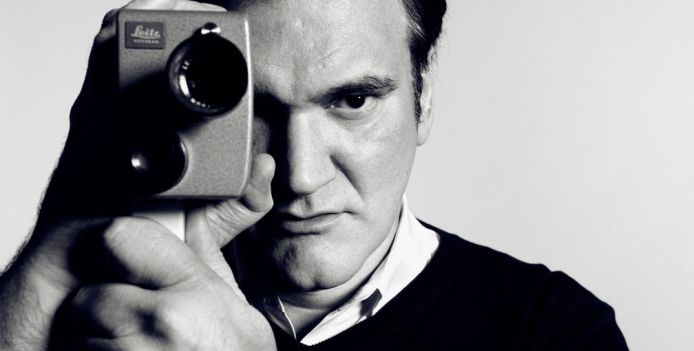
John is a Sophomore at Haverford College and a lifelong…
Controversial, unapologetic, and brilliant all at the same time, Quentin Tarantino is one of the most unique directors in film history. Dropping out of high school at age 15 to pursue acting and his love of films by working at a video rental store, Tarantino developed a unique understanding and appreciation for movies that cannot be taught in a formal setting. His films are notorious for gratuitous violence, pop culture references, and extended scenes of dialogue. Usually running well over two hours, these movies are stuffed with an incredible amount of tension, comedy, and action blended into incredibly entertaining, interweaving stories.
Often working with the same actors, Samuel L. Jackson, Uma Thurman, and Christoph Waltz, to name a few, Tarantino’s films are always rooted in a classic genre: Reservoir Dogs as a heist picture, Jackie Brown as blaxploitation, Kill Bill as a classic martial arts movie, Django Unchained as spaghetti western, et cetera. While he has contributed as a writer and director to many pictures, this article will focus on his most famous and most influential works. With the upcoming release of The Hateful Eight in 2015, let’s go through Tarantino’s most impressive credentials.
Reservoir Dogs (1992)

Written in just three weeks, Reservoir Dogs put Tarantino on the map and immediately acquired a huge cult following. Starring Harvey Keitel, Steve Buscemi, and Tim Roth, the film is centered around a group of thieves and a diamond heist gone wrong, but that doesn’t even begin to describe what Reservoir Dogs really is. Taking place almost entirely in an empty warehouse, the film balances intense dialogue with extremely graphic outbursts of violence, something that would become a staple of Tarantino movies as his career developed. The actual heist itself is never shown, but is instead discussed by the characters afterwards as they try to sort out what happened.
The film is gripping, fast paced, and often shocking. For those unfamiliar with Tarantino‘s work, this is a great place to start. With so many memorable scenes, including the infamous “Stuck in the Middle With You” sequence, it will leave first-time viewers hungry for more. Reservoir Dogs was a hit at worldwide film festivals that year, earning awards at the Toronto, Stockholm, and London International Film Festivals to name just a few.
Pulp Fiction (1994)
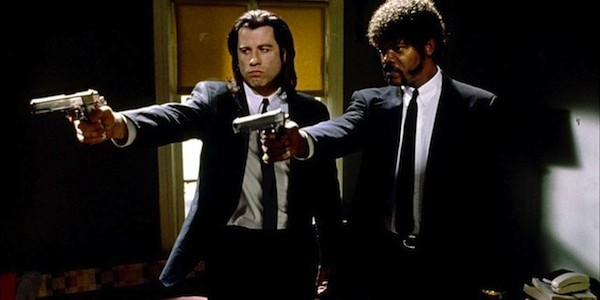
Many filmmakers have trouble following up a successful debut. In Tarantino‘s case however, his sophomore effort is arguably the best of his career so far. The film jumps around chronologically, following different characters whose misadventures often collide and intertwine. Pulp Fiction has been said to have saved John Travolta‘s career; he plays a drug-addicted hitman who struggles with authority and morality. Samuel L. Jackson, Bruce Willis, Uma Thurman, and Ving Rhames also play major roles in the sprawling tale.
The thing that really makes Pulp Fiction a masterpiece is not the performances, which although good, were only made possible by the unique, unforgettable writing. Tarantino really explores his style with this film. Running at just over two and a half hours, there is plenty of room here for the characters to undergo extended diversions, unexpected epiphanies, and episodes of sudden, explosive violence. The dialogue is quick, witty, and often irrelevant, and it is in this dialogue where Pulp Fiction soars. The impeccable screenplay earned Tarantino an Academy Award, Golden Globe, and numerous other honors.
Kill Bill Vol. 1 (2003)
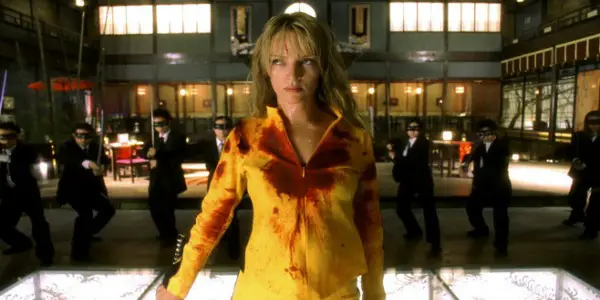
After the moderately successful Jackie Brown in 1997, Tarantino headed into even more stylized, ultra-violent territory with Kill Bill Vol. 1. An homage to the martial arts films of the 1970’s with elements of classic westerns, the film features Tarantino‘s now trademark dialogue along with much more gratuitous violence. The story is about The Bride (Uma Thurman), a former assassin who is out for revenge against her old colleagues, led by the mysterious Bill (David Carradine). As she awakens from a coma onset by an unexpected assassination attempt, The Bride embarks on a mission of revenge, a pledge to take out every member of The Deadly Viper Assassination Squad, including Bill himself.
Kill Bill is all about style. The film really embraces its martial arts inspirations, often referring to and mimicking scenes from Hong Kong classics. Because it’s Tarantino there is still plenty of dialogue in the film, however, the most memorable scenes this time around are the ones involving the over-the-top action. The climactic battle between The Bride and the Crazy 88’s is one of the most graphic, absurd fight scenes ever made, but it works perfectly in the context of what Kill Bill is trying to be. When it comes down to it, the purpose of this movie is raw entertainment. The overdone, generic plot is just the foundation on which Tarantino builds his work. It provides the parameters and themes of what the martial arts genre has to offer, which he can manipulate and tailor into something wholly unique.
Although 2004’s Kill Bill Vol. 2 is a commendable follow-up, Vol. 1 really set the precedent for just how unexpected, versatile, and brilliant Tarantino could be. Met with somewhat mixed but generally positive reviews, the two films marked a refreshing shift in his career, proving that Tarantino can succeed in a non-gangster genre.
Inglorious Basterds (2009)

This time drawing from classic World War Two films as well as implementing noir elements, Inglorious Basterds spins history on its head with expert pacing, dialogue, and acting. Featuring Christoph Waltz as a sadistic Nazi “Jew-Hunter”, the film deals with morbid historical issues, something that Tarantino‘s next film, Django Unchained, would do as well. However, this movie is not about The Holocaust, or World War Two, for that matter. They merely serve as context, background information, for the film’s characters to play into and interact with. Some of Tarantino‘s best written dialogue is in this piece, and with an Oscar-winning performance from Waltz, some of the best acting too.
Most contemporary films made about World War Two have a very serious, realistic essence. Classics such as Schindler’s List, Saving Private Ryan, and Letters from Iwo Jima all attempt to depict the brutal reality of wartime atrocities. In Basterds, this violence is presented with over-the-top style in a more entertaining, lighthearted fashion. Brad Pitt‘s Lt. Aldo Raine is a hilarious, charismatic, figure. He, along with Waltz’ Hans Landa are pure movie characters. They exist only in the universe of Tarantino, and that is something that must be kept in mind when watching his films. Representing yet another genre shift, Inglorious Basterds proves that Tarantino‘s movies can be treated as homages to film classics while simultaneously adding something original to these genres.
Django Unchained (2013)
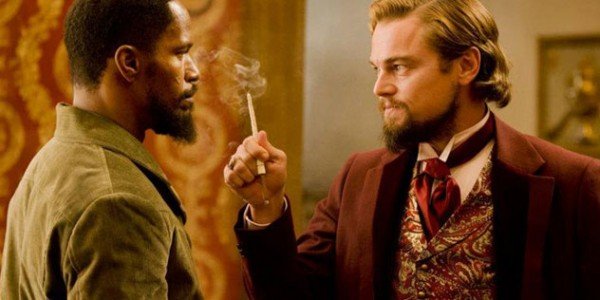
At this point in his career, Quentin Tarantino has explored so many different film realms that writing and directing a Spaghetti Western is not a very surprising jump. Django Unchained embodies the classic revenge story of the old west. However, this film is also about the institution of slavery in the south, and the ways in which it dehumanized people on both sides of it. Jaime Foxx stars as Django, a freed slave on a mission to rescue his wife. Christoph Waltz returns as a former-dentist-turned-bounty hunter, a role that was written specifically for him. Leonardo DiCaprio and Samuel L. Jackson also give strong performances as the corrupted residents of Candieland, one of the largest plantations in the south.
While Django deals with very serious themes, it still retains the entertaining aspects of Tarantino‘s work. There is the gratuitous violence, quick-witted dialogue, and expert pacing that comes standard in his films. The movie does a great job of balancing the brutal reality of slavery with satisfying acts of retribution and moral righteousness. This is a film made by a director in his prime. While it is undoubtable that Reservoir Dogs and Pulp Fiction are his masterpieces, Django Unchained employs and builds upon such classics in a way that feels as though Tarantino is still learning, innovating, and improving with each film he makes.
Coming Soon: The Hateful Eight (2015)
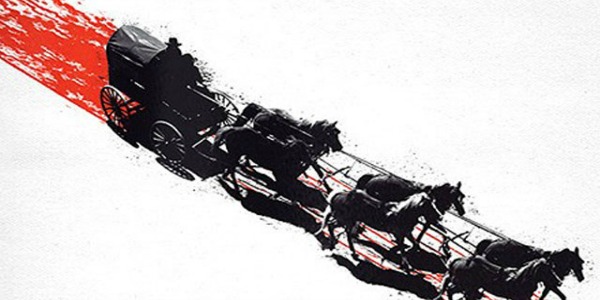
Pitched as “The Eighth Film from Quentin Tarantino,“ The Hateful Eight is set in Wyoming during the late 1800’s. Not much is known so far about the plot, other than the involvement of eight people trapped in a room together during a blizzard. This synopsis feels like the perfect recipe for a Tarantino movie. I’m sure that it will involve conflicting beliefs and moralities in Reservoir Dogs fashion, while managing to capture the tension and spectacle of Inglorious Basterds and Django Unchained‘s best scenes.
Announcing recently that he plans to retire after ten films, Tarantino has certainly retained his sense of mortality, acknowledging that he will not be in his prime forever and that his contribution to cinema is just a piece of a larger whole. Therefore, that leaves the world with only two more Tarantino pictures after The Hateful Eight. Where will he go next? Perhaps he will tackle a new genre, or return to one previously visited. Kill Bill Vol. 3 has been announced, however it is unclear whether or not this will add a tally to the list, since volumes 1 and 2 have often been considered one film.
What do you think Tarantino will do next, and what genre would you like to see him tackle? Do you agree that he is getting better as a director, or do you think he will never recapture the magic of his roots? Leave your thoughts below!
(top image source: LevonBiss.com)
Does content like this matter to you?
Become a Member and support film journalism. Unlock access to all of Film Inquiry`s great articles. Join a community of like-minded readers who are passionate about cinema - get access to our private members Network, give back to independent filmmakers, and more.
John is a Sophomore at Haverford College and a lifelong movie fan. He plans to major in English with a Film Studies minor, and loves watching, analyzing, and writing about films.













